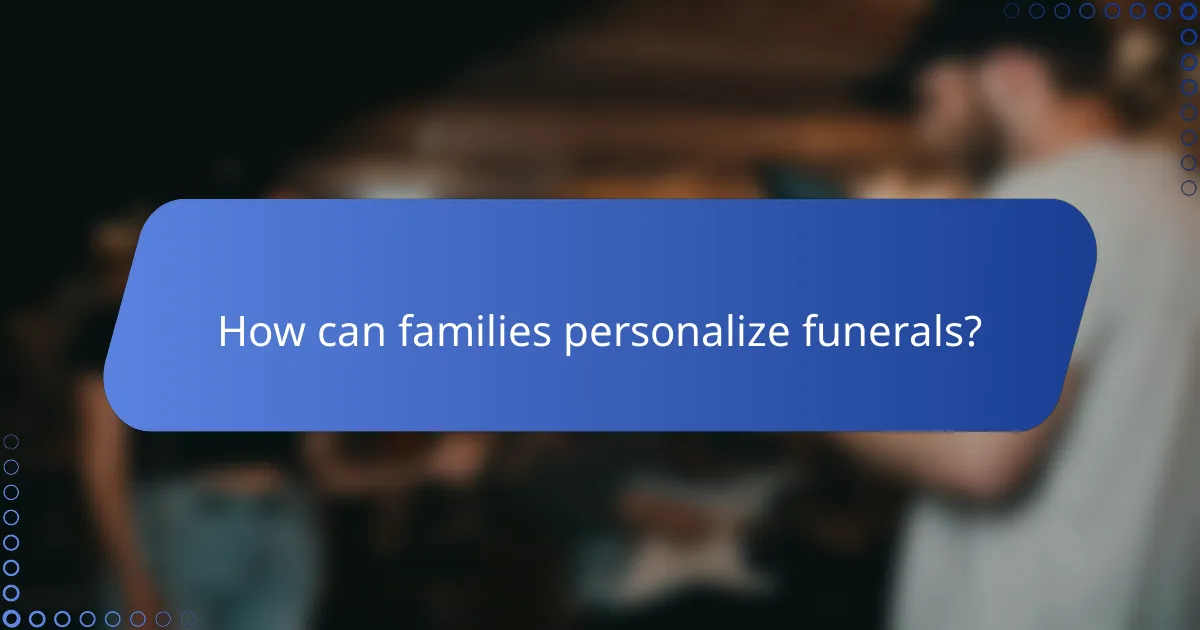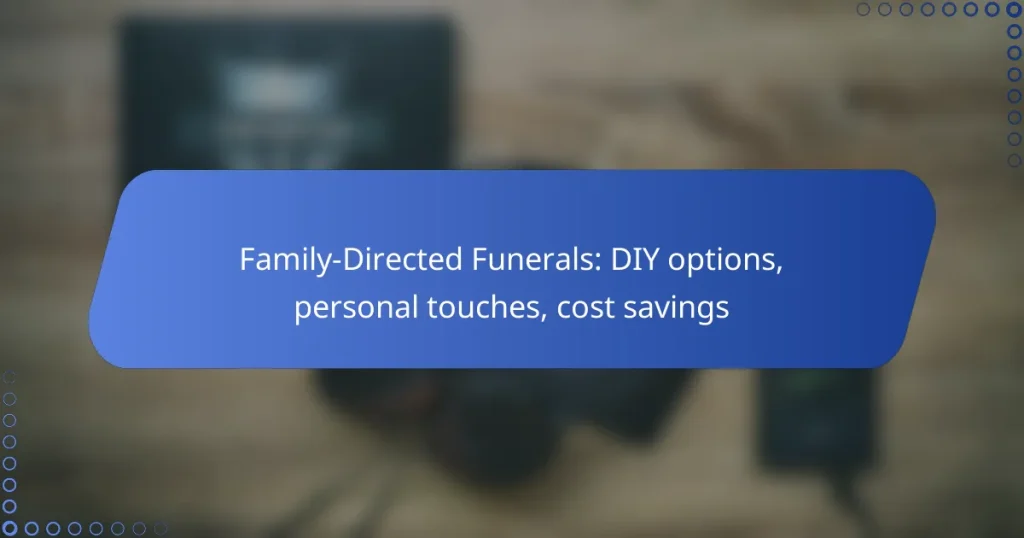Family-directed funerals provide a meaningful way for loved ones to actively participate in the planning and execution of memorial services, often resulting in a more personalized and budget-friendly experience. By exploring options such as home funerals and green burials, families can incorporate unique elements that reflect the life and values of the deceased, while also implementing cost-saving strategies like DIY arrangements and direct cremation to minimize expenses.

What are family-directed funeral options in Canada?
Family-directed funeral options in Canada allow families to take an active role in planning and conducting funerals, often leading to more personalized and cost-effective services. These options include home funerals, green burials, and memorial services, each offering unique benefits and considerations.
Home funerals
Home funerals involve caring for the deceased in a familiar environment, allowing family members to participate in the process. Families can wash, dress, and prepare the body, which can foster a sense of closure and connection.
In Canada, home funerals are legal, but it’s essential to check provincial regulations regarding handling and transporting the body. Families should also consider hiring a funeral director who supports this approach to ensure compliance with local laws.
Green burials
Green burials focus on environmentally friendly practices, using biodegradable materials and natural settings. This option often involves minimal embalming and simple caskets or shrouds, allowing the body to decompose naturally.
In Canada, many cemeteries offer designated green burial sections. Families should research local options and understand any specific requirements, such as site selection and permitted materials, to ensure a sustainable burial experience.
Memorial services
Memorial services are gatherings held to honor and celebrate the life of the deceased, often without the body present. These services can be customized to reflect the individual’s personality and values, making them a meaningful tribute.
Families can choose to hold memorial services in various locations, such as homes, community centers, or parks. Considerations include the service’s format, guest list, and any personal touches like music, readings, or shared stories. Planning ahead can help manage costs and ensure a memorable experience for attendees.

How can families personalize funerals?
Families can personalize funerals by incorporating meaningful elements that reflect the deceased’s life, values, and relationships. This can include custom memorial items, personalized eulogies, and unique venue choices that create a memorable and heartfelt farewell.
Custom memorial items
Custom memorial items serve as lasting tributes that honor the deceased. Families can create personalized keepsakes such as engraved jewelry, photo albums, or custom artwork that encapsulates cherished memories. These items can be distributed among family members or displayed at the service.
Consider incorporating items that reflect the deceased’s hobbies or passions, such as a favorite book, sports memorabilia, or handmade crafts. This adds a personal touch and invites guests to share in the individual’s story.
Personalized eulogies
A personalized eulogy is a powerful way to celebrate a loved one’s life. Family members or close friends can share anecdotes, memories, and qualities that defined the deceased, making the service more intimate and relatable. Aim for a length of about five to ten minutes to keep the audience engaged.
When preparing a eulogy, focus on specific traits or experiences that highlight the person’s character. Including humor or light-hearted stories can provide comfort and create a warm atmosphere during the service.
Unique venue choices
Selecting a unique venue can significantly enhance the personal touch of a funeral. Instead of traditional funeral homes, families might consider locations like parks, community centers, or even the deceased’s favorite café. This choice can reflect the individual’s personality and create a more relaxed environment.
When choosing a venue, consider accessibility for guests and any necessary permits or regulations. Outdoor venues may require contingency plans for weather, while indoor spaces should accommodate the expected number of attendees comfortably.

What are the cost-saving strategies for funerals?
Cost-saving strategies for funerals include planning DIY options, utilizing online resources, and opting for direct cremation. These approaches can significantly reduce expenses while allowing for personal touches that honor the deceased.
DIY funeral planning
DIY funeral planning allows families to take control of the arrangements, often leading to substantial savings. This can include organizing the service, selecting a venue, and even preparing the body, depending on local regulations.
Consider creating a checklist to manage tasks efficiently. Key elements might include securing necessary permits, choosing a casket or urn, and coordinating with suppliers for flowers and catering. Engaging family members can also help distribute responsibilities and foster a sense of togetherness during a difficult time.
Using online resources
Online resources can provide valuable information and tools for planning a funeral without incurring high costs. Websites offer templates for obituaries, budget calculators, and guides on legal requirements, which can streamline the planning process.
Many funeral homes now offer virtual consultations, allowing families to compare services and prices easily. Additionally, forums and social media groups can connect individuals with shared experiences, providing support and advice on cost-effective options.
Choosing direct cremation
Direct cremation is a straightforward and economical choice, typically costing less than traditional burial services. This option involves cremating the body shortly after death, without a formal service beforehand, which can eliminate many associated costs.
Families can still hold a memorial service later, allowing for personalization while keeping expenses low. It’s essential to compare prices among local providers, as costs can vary widely, often ranging from a few hundred to a couple of thousand dollars depending on the services included.

What are the legal requirements for DIY funerals in Canada?
In Canada, DIY funerals must comply with provincial regulations, which can vary significantly. Key requirements typically include obtaining a death certificate, adhering to transportation laws, and ensuring proper handling of remains.
Death certificate acquisition
To conduct a DIY funeral, you must first acquire a death certificate, which is essential for legal and administrative purposes. This document is usually obtained from the provincial vital statistics office where the death occurred.
The process often involves submitting a completed application form along with the required identification and, in some cases, a fee. It’s advisable to check the specific requirements for your province, as they can differ in terms of processing time and costs.
Transportation regulations
Transportation of the deceased must comply with local regulations, which govern how remains can be moved. Typically, you will need a suitable vehicle that meets health and safety standards, and you may be required to use a certified funeral service provider for certain transport aspects.
In many provinces, if you are transporting the body over long distances or across provincial borders, additional permits may be necessary. Always verify local laws to avoid legal complications during the transportation process.

What supplies are needed for a DIY funeral?
Planning a DIY funeral requires a range of supplies to ensure that the ceremony is both respectful and personal. Essential items include a casket or alternative container, transportation means, and materials for memorialization, among others.
Funeral home supplies
When organizing a DIY funeral, you may still need some supplies typically provided by funeral homes. This can include a basic casket or an alternative container, which can range from simple wooden boxes to biodegradable options. Additionally, you might require a hearse or other transportation for the deceased, which can often be rented from local funeral homes.
Consider also obtaining necessary permits for burial or cremation, as regulations can vary by location. Check with local authorities to ensure compliance with any legal requirements.
Embalming alternatives
Embalming is not always necessary for a DIY funeral, especially if the body will be buried or cremated shortly after death. Alternatives include refrigeration or using dry ice to preserve the body temporarily. These methods can be more cost-effective and environmentally friendly.
Natural preservation techniques, such as using essential oils or herbal mixtures, are also gaining popularity. However, it’s essential to research and understand the effectiveness and legal implications of these methods in your area.
DIY memorial kits
DIY memorial kits can help personalize the funeral experience. These kits often include items like memorial cards, guest books, and keepsakes that family members can customize. You can find kits online or create your own using materials that reflect the deceased’s personality and interests.
When selecting or creating a memorial kit, consider incorporating photographs, favorite quotes, or personal mementos. This adds a unique touch and helps celebrate the life of the loved one in a meaningful way.

How can families involve children in funerals?
Families can involve children in funerals by encouraging their participation in meaningful activities that honor the deceased. This engagement helps children process grief and understand the significance of the ceremony.
Creating memory boxes
Memory boxes are a tangible way for children to connect with their loved ones during a funeral. Families can gather items that remind them of the deceased, such as photographs, letters, or small mementos, and place them in a decorative box.
To create a memory box, start by selecting a sturdy container, such as a shoebox or a small wooden chest. Encourage children to personalize the box with drawings or stickers, making it a unique tribute. This activity not only fosters creativity but also allows children to express their feelings about loss.
Consider setting aside time during the funeral or memorial service for children to share their memory boxes with others. This sharing can help facilitate conversations about the deceased and provide comfort to grieving family members.


